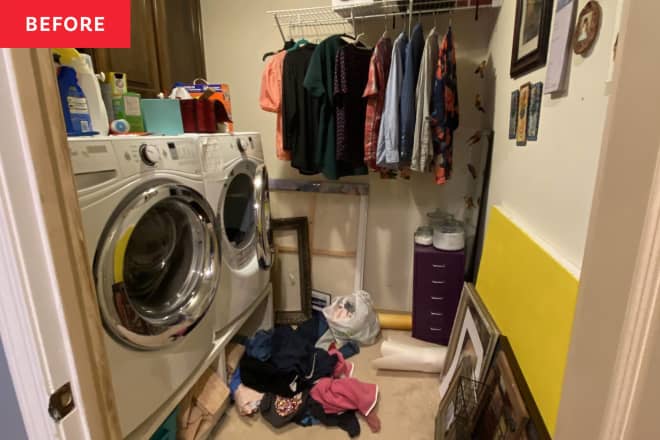“Clutter headquarters” no more. See this laundry room’s beautiful makeover.
READ MORE… | BidBuddy.com
An ‘80s Laundry Room Goes from “Clutter Headquarters” to Organization Goals
How NAR’s $418 Million Settlement Impacts Home Buyers and Sellers
The National Association of Realtors (NAR), the organization that has established homebuying and selling rules since 1908, has announced an agreement to settle a series of home-seller commission lawsuits.
NAR lawsuit background
In October 2023, a federal jury determined that the National Association of Realtors (NAR) “conspired to require home sellers to pay the broker representing the buyer of their homes in violation of federal antitrust law.” The court determined that the NAR’s commission structure and rules infringe upon antitrust laws because they essentially forced home sellers to pay a fee that could be paid by the homebuyer.
One of the original 2019 class action lawsuits was filed by nearly 500,000 property sellers in Missouri, alleging that this forced commission hurt both buyers and sellers financially. The suit claimed that sellers, who were required to pay the commissions for both agents, compensated for the loss by increasing list prices, putting buyers at a disadvantage, and inflating home costs nationwide.
In an interview with The Associated Press, Michael Ketchmark, one of the attorneys representing the plaintiffs in the lawsuits, said, “What’s at issue nationwide is costing Americans about $60 billion in extra real estate commissions.”
Realtors and brokers (collectively referred to as the NAR) were ordered to pay nearly $1.8 billion in damages. The ruling signaled a significant shift in regulatory oversight.
NAR agrees to pay $418 million settlement
On March 15, 2024, the NAR announced that it would settle this series of lawsuits for $418 million. The historic court agreement ends all litigation claims brought by home sellers.
“Ultimately, continuing to litigate would have hurt members and their small businesses,” said Interim NAR Chief Executive Nykia Wright in a statement. “While there could be no perfect outcome, this agreement is the best outcome we could achieve in the circumstances. It provides a path forward for our industry, which makes up nearly one fifth of the American economy, and NAR.”
Wright added that the association was staying true to its mission. “For over a century, NAR has protected and advanced the right to real property ownership in this country, and we remain focused on delivering on that core mission.”
9 things to expect from the NAR settlement
The settlement will still need a federal court’s approval, but here is an at-a-glance list of what happened, and what home buyers and sellers can expect:
1. Court settlement may revolutionize U.S. home buying and selling
This groundbreaking court settlement is poised to dramatically alter the traditional business model of buying and selling homes in the United States. The traditional 6% commission that’s usually split between the buyer and seller agents will see sweeping changes.
2. Class-action damages to benefit millions of home sellers
It’s estimated that tens of millions of home sellers may be eligible to receive a small portion of a consolidated class-action damages payout.
3. End of mandatory commission fees
As part of the settlement, the NAR must eliminate long-held commission requirements. The organization is now banned from establishing rules that would permit a seller’s agent to set compensation amounts for a buyer’s agent. It’s predicted that this restriction will discourage buyer’s agents from “steering” home shoppers to higher-priced properties in an effort to collect a larger commission.
4. MLS subscription requirement removed
The settlement also removes the requirement that real estate agents must subscribe to the multiple listing service (MLS) in order to offer or receive transaction commissions. (The majority of MLS sites are owned and operated by local NAR affiliates.)
5. Broker compensation fields to be removed from MLS systems
As part of the required changes, fields displaying broker compensation must be eliminated from MLS systems.
6. NAR membership may see a decline
This decoupling of agent commissions and MLS access could lead to fewer agents feeling compelled to be members of the National Association of Realtors. NAR currently has 1.5 million members involved in every aspect of residential and commercial real estate.
7. Expected decrease in agent commissions
While Realtor fees were always negotiable, industry experts predict that by eliminating the fee guarantee, agents will need to compete more for business, which will likely lead to lower commissions, possibly up to 30%, which could bring down nationwide home prices and lower costs for homebuyers and sellers. For example, if the traditional commission on a median-priced $400,000 home was $24,000 — normally split between the buyer’s agent and the seller’s agent — the new fee structure could reduce the Realtor fees to $16,790.
Agents representing a buyer will likely have to negotiate their commission either with a buyer upfront or at the time the purchase offer is made. The new approach may also result in fewer buyers using Realtors. | BidBuddy.com
We Just Found One of the Best Deals on Apple AirTags (Just in Time for Spring Travel!)
How to Buy Your First Rental (8 Beginner Steps)
This Surprising Wallpaper Trend Is Back for 2024 (It’s Renter-Friendly!)
It’s easier to apply and more affordable than traditional or peel-and-stick wallpaper.
READ MORE… | BidBuddy.com
Milwaukee 15-Gauge Finish Nailer: A Hands-On Review
If you’ve been searching for a dependable cordless nailer with the power and speed of a pneumatic, look no further. | BidBuddy.com
I Test Bedding for a Living, and This Is the One Item I Recommend for Comfortable Sleep All Year Round
Motions Being Made That Are Not On The HOA Meeting’s Agenda
The Annual Meeting of Nottacare Condominium convenes. The Agenda shows the standard items including Review Minutes, Financial Report, President’s Report and Election of Directors. As usual, only 20% of the 95 members show up. But the board has been proactive in getting proxies from the rest so having a quorum is not a problem. The president proceeds systematically down the distributed Agenda. After approving last year’s minutes and a year to date financial overview, she moves towards elections in hopes of wrapping up business early so the wine tasting and potluck can begin. But wait! Millie, a longtime resident, rises to her feet and says “Madam President, I’d like to propose a motion to amend the governing documents to eliminate renters. I’m sick and tired of all the coming and going and lack of regard for us owners.”
{loadmoduleid 306}
The President responds, “Millie, I’ve had the same concerns. Do I hear a second?” A second comes from the back of the room and soon a lively discussion ensues about the pros and cons of renters. Bill comments “This all seems a bit hasty and aren’t there federal Fair Housing regulations to consider?” Mary, who rents her unit out, says “I just signed a one year lease with my tenant. What do you expect me to do now? Besides, I bought the unit so I could rent it out. There were no restrictions against it.” Joe jumps to his feet, “Who cares? We need to get rid of those people. Let’s change the rules and move’em out!” After much haranguing and gnashing of teeth, a vote is called for and a majority of 10 of the 19 present plus another 40 proxies held by the Board President vote to eliminate rentals.
Many believe that the Annual Meeting is a place that the members can be heard and the system changed. While that’s true to an extent, certain aspects of it must be handled to protect the rights of all members, particularly the ones that aren’t present. For that reason, no motions can be entertained that are not on the Agenda which has been distributed with the Annual Meeting Notice to all members. If HOA amendments or policy is to be voted on, all members must be informed ahead of time so they can participate in the discussion. Allowing someone to make spontaneous motions disenfranchises members that aren’t at the meeting. It’s up to the Board President to call such motions “out of order”.
The easiest way to head off such spontaneity is to advise all members prior to the meeting when the Annual Meeting Agenda is being compiled and ask for any proposed amendments or policy changes by such and such a deadline. Add further that no motions can be entertained at the meeting itself unless they are on the Agenda and explained in enough detail so that all members understand what they are and the implications. Proposed amendments should always be reviewed by the attorney prior to enactment.
Restricting motions does not mean that members are not allowed to speak their mind. That is one of the purposes of the Annual Meeting. Free speech helps the members to winnow through issues and come to either an agreement or an agreement to disagree. Encouraging this kind of discussion is good.
But in the case of Millie’s Motion, the proper response from the Chair should have been “Thank you for your suggestion Millie. Why don’t you circulate a petition to all the members to see if there is strong support for restricting rentals? Have the supporters sign your petition and if there are enough, we can either hold a special meeting or vote on it at the next Annual Meeting. Does anyone else have anything they want to discuss before we move on to elections?”
Amending the governing documents or policy should never be done on the spur of the moment. There are few issues that are so urgent that can’t wait for proper review and feedback by all members. If confronted by a Millie’s Motion situation, help guide the process to a thoughtful conclusion. | BidBuddy.com
Balloon vs. Hybrid. Same? Different?
In the mortgage biz, there are a couple of terms that might sound a bit funny but in fact describe a particular type of home loan. These two terms, balloon and hybrid, do have similar characteristics but are slightly different from one another. So they’re not exactly the same, but pretty close.
{loadmoduleid 306}
A balloon mortgage is rarely found today, at least in its original sense. A true balloon mortgage is one where while the loan is amortized over a preset period, typically 30 years, but after a certain initial period, the entire note comes due. All of it. So someone with a balloon mortgage would enjoy slightly lower rates compared to a fully amortized fixed product, upon the end of the initial period the entire balance must be paid off. Usually this was done by refinancing the note entirely into a new one.
Balloons were rather popular during their time, primarily leading up to the 2008-2009 mortgage debacle. As rates began to rise, borrowers who needed to refinance out of their balloon mortgage found that rates had gone up to the point where they couldn’t qualify. Instead, they had to sell. So did a lot of other folks. So many so that the market was saturated and people found they owed more than what it was worth in the current marketplace. Lots of foreclosures happened. Soon, the Feds began retooling the mortgage landscape and true balloons vanished. Instead, they turned into hybrids.
Okay, so what is a hybrid? A hybrid is a mortgage where the start rate is a bit below a fully amortized one and fixed for an initial period, like a balloon. Unlike a balloon however, it would automatically morph into an adjustable rate mortgage.
A balloon would be signified by a 30-5 symbol. This means the loan was amortized over 30 years but provided an initial fixed rate for five years. After that, it’s time to replace the current mortgage or pay if off entirely. A hybrid mortgage couild read 5/1 which also means the initial term was fixed for five years but at the end of five years the loan would automatically turn into an adjustable rate which could adjust once every year for the life of the loan. Instead of the entire balance coming due after five years, the loan simply changed into an adjustable rate mortgage. | BidBuddy.com


 Facebook
Facebook
 X
X
 Pinterest
Pinterest
 Copy Link
Copy Link









